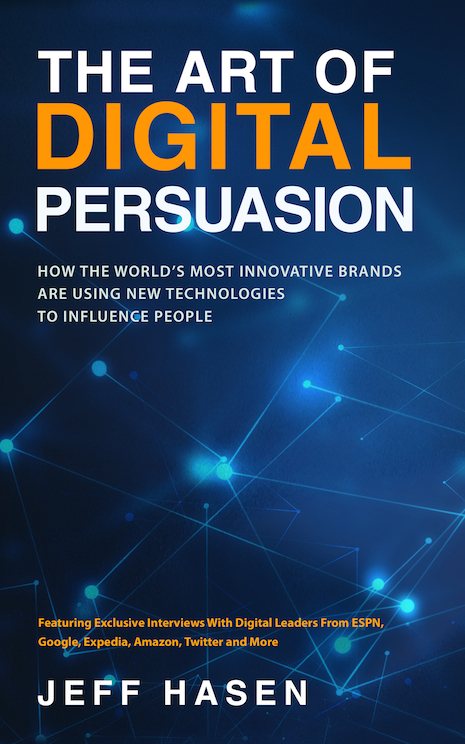By Jeff Hasen
To believe that Dallas-based apparel retailer Neiman Marcus first discovered innovation in its second century is to make an error approximately the size of Texas.
One can go all the way back to the day it opened in 1907 to see evidence of the retailer’s forward-thinking and acting.
It was the first to offer upscale fashion to the state’s wealthy, according to Wikipedia.
In 1927, Neiman Marcus premiered the first weekly retail fashion show in the United States.
On the mark
Neiman Marcus’ history of innovation is deep, and while nearly everything around it has changed, the retailer has survived in large part by its boldness.
“A company like Neiman Marcus didn't manage to survive one hundred and ten-plus plus years without being innovative,” Scott Emmons, the longtime head of the company’s innovation lab (or ‘I Lab’), told me in an exclusive interview for my new book, The Art of Digital Persuasion.
“It’s not like innovation just got invented over the last 10 years because there were iPhones,” he said.
Yes, on one hand, you can argue that Neiman Marcus has been there, done that. But these are extraordinary times for the retail industry.
Brick-and-mortar stores by the thousands are shutting down. Businesses are needing to compete based on not just price, but on such factors as the ability to deliver purchases in two days or less and through the use of technology that digitally puts such things as eyeglasses on one’s face, a dining room table in one’s house, and product reviews in the palm of one’s hands.
“What we're seeing is how quickly the new disruptive ideas keep coming at businesses, and their efforts to keep up with that rate of change, be more agile, and be able to bring new ideas to the table faster,” Mr. Emmons said.
Those ideas have led to emerging tech such as voice, augmented and other flavors of reality, artificial intelligence, and more.
When I asked Mr. Emmons for advice for marketers, he preached a path of managed risk.
“There is a real temptation to go out and try that bright and shiny thing just because it's cool and everybody is talking about it, and there is all kind of buzz around it,” Mr. Emmons said.
“But in the end, you go back to the simple question of what kind of projects should we be tackling. Does it solve a real problem? Or let it evolve from being a solution looking for a problem to something that can solve a problem that you've identified that you have. That's how I look at it.”
 The Art of Digital Persuasion, by Jeff Hasen, April 2019
The Art of Digital Persuasion, by Jeff Hasen, April 2019
How it lines up
When it comes to ROI, one size does not fit all.
“I think the type of projects that we work on are varied enough that those metrics tend to be different,” Mr. Emmons told me before leaving Neiman Marcus to join TheCurrent Global consultancy.
“If you're working on an RFID project, maybe our metric is did we get our level of inventory accuracy to ‘X’ percent and because our inventory accuracy was better, we lifted sales by this much,” he said. “You can apply actual traditional lift measurement to see how well something is performing.
“Then you have other types of experiences that have never been done before. And the amount of work it takes to actually tie it back into your transactional systems is large. And so it may be worth it just to try that experience and see if the customers like it, and observe how they interact with it, and sort of take a test drive and not necessarily have a defined ROI on it.”
Others I interviewed offered invaluable advice as well:
ESPN, all over your television guide and digital channels, notably uses a yardstick that measures how well as opposed to how many.
“Quality always wins,” Ryan Spoon, ESPN’s senior vice president of digital and social, told me. “And that pertains to any job. Whether you're creating the content, creating a product, you're distributing the content, marketing it, whatever that might be.”
To those seeking clarity on the question of when they will master digital marketing, Google vice president of performance media Jason Spero believes that it is all tied to delivering for consumers.
“It's likely the question of when we get to the finish line might be the wrong metaphor,” Mr. Spero explained to me.
“But rather how do we recognize consumers’ expectations and how might we be able to serve her needs in a way where she may not see the technology, but she's delighted by the experience?” he said.
WHAT I LEARNED in writing The Art of Digital Persuasion is that successful businesses and marketers innovate to differentiate.
The first action for you to take is to place that 2018 marketing playbook in the trash. That was then. The question is what are you going to do now?
 Jeff Hasen
Jeff Hasen
Jeff Hasen is a strategist at Possible Mobile and was written three books, including the newly released, “The Art of Digital Persuasion.” Reach him at [email protected].
{"ct":"vPce491zF4\/hkU0FGx7CFw2EUJWwWZCtHaxvgMSXc14To1CNSicg8xbnXhRm8xsIUobRDtJ8bqIvdSaXQ39KBeI90L6QEM+21tVhWcEmZ2qjtFtCXumYoORxApnpPEddzB95cNK0pHTB1wu6a1GvRiQj\/ZoOaLP7hxiCv3OXxJVxKAXggCklBah5Vv9nU8fkk2YwpOjSgPmPx\/oqepMyzmKyLkNK17tx66gneADyKrI3ixoaA0tLXjgVSxCe8LcngB9JIHIKahdlnwmmnsvOjWbfp2pSHwYNjejaBaruTSS83wXSIdueGOi+0QOZZRTsnrpE9tdlIVZ4FUKagB0ROUAxDADaz\/dWIW9iBnGWkcdrp+GBl+t1NGkplosWos7RJZxwYLCxxjP3eHXM2uZk2CHXh5qpkIhTcXn+8MhAYR1itySNJyXUAO7m9QU1qr0PeRD05D\/oHHXmutk6bWIZmg1kGBx\/6NQX+MrMPQUkdrDIvtr3tkaJswjTXXUqH8vWqH3det1uzfeyBnJAR9RX4JWx1XgBUmGlYpxlPq4McYLbnfwSoqelYIa26dxvM5P6477S72xWV7P7r\/glID9z9VC1NQUhRhAEA8WIc5u7vVAu+TSnrjy31hTpI2btRkiAQVWIKVSobcM+6ioWB3AUa77h2s+oRs3yDrSV6nQ1iJC6Tn0w\/e0Ip4aT72S0IFkkstvwTczZl7l2f7Gh8JRbzFoZ3fr+NmTHlhFmpdR+lutFF8GHyR73OlQNATuHFNK0RIyLz9xNC\/7llJuNaW2nvt0PFYhTXFCStU+nKzDj66Er58JYG6EiQQ6TeeAnGG2fNKpt0YCA\/24QyQvfI5pD1yWmD7vr56Jeaeo00NKI9KINM0dmBmX7qNwuut6O42TtVxVgoReRKynd4AUXgb0vcVdMBGjKVMdUFzQ65WUSEkfcrLdLjtOZpgMGMRKUHzMGbn6dCQpFW\/\/qgnVsW8TKz3szFllpKDZw4ZBzDHPdTj\/yJ2oEkdMq9igubC4XjwZta29YGS63731LkFIkaWlbdBGbZ8zVcxNgfEiGqgMf186RpdV40HGCw14lzV7L+vOjoMQ702V2NiksIZ7tNbYdNIp9oAQNtNU\/mAdsgAl3gDY7wtXrBoruBHc\/m\/9gJy3Kkim2KToWPvWZ1HI3vku+uS1\/bBdVTDTPgl4CJ2UCXDD12fvbrKQKeMGJrNpOhHZfzeuAWgthJazz7TifkIGKtQZErH3+jsn5SgCWb7iCSbJBXd+s5VrbwLzNO5EWvipfRCVWR2Qd7pU68G0XgooSrLgo4+oqZuVfoFJJQA2hQ2fxP1q39auD905drlJmgDiHv6G+mkIsgZrNz4BqDZDQkHeSSOW7epwp5BuXeCOeh7GCDBMOAU5BAybdkGDT737xvXaj1JyRaxYxP5hzCdOfnz51Hmuq4h7\/TmvI1glwPWpjbx9qSp7r1jNh+\/MFILB\/MzSRJeIuKPJw8XrNhvPmvTCeuu\/E\/fGVSu5cImNDVvKuAtq0dXg8Cn0qT+0bddf9wNMZaE0KQqV\/JWg+18bfuuJugB43a3WIANnfzbq+uPl3kftbnghr16hCn4bCnAsB+3T9WD0otiftMJoo+IB1v6ajDf5kPxGUQZ4gSWanyQz\/ypiQW8OZgNfsFWG0BzGonBMiZv+11A1nLL5R1PhAUCmglaEdukAXLrUgPch79dTKXpuyFz+IoksoeiTS8FLph4fpSWC1+\/C+XJfKlm1u6xVzB7F4EPGgJFLvFQm62J8tYIspPv74LzkgWFSxX\/0bhwhrrKiLd3c42\/ur+oxXFrCmdh15VK0If\/kvGzV0vXwpGf7EcQ\/y2432NP73dGiSj7zuQ7fYR3p7ZCqFyvQBCWz\/ikf58AJ5Ndm1HI9DxkbnYO+vOBUdI\/WTM9E23J+mCQXPrI4K+T411kVQWr+cBnkZYMOk9EGMv6R1q4LCncmHpWjyjCZjgUvrgaXoeavdSpZNQiT0dVwB68umpOO21RtI+FFNmyRUoMAe1yTLLeBDEOyN6pXOlYMv1NQ7a60K7XdHD8znhFtbe4Sa\/mSWmP0nOLxJJGy20DQF+mvJG9F3A052u66k2oFT5QJqcvaJzxLvH+Coj+M4rm0d7VgJuTGI01WpK+Jo2NsK7DgTtUvBvnvzYQH2Moz6pbsTXmOHmt9vm5ZbNJLpa3wCWZ6GaUJq00K8RCM1ABaFS3PE50wcLfqbjF7UL1ye47N0\/PugPRUUSs+7EkKFNmksU0W4ZD7h6wETt1AT5W5XInj5S\/U0109yZPEh72jt69eIu2MLXAmP1MzawCqGHG83csYtW6ernzVC8sKt3NDQRmo3KRB7hY+lMxbq4rhyOYqazvEFf3u7GJia1dK33Bmmei4ozKqUk5LHUCmbubufvOrpzghoCjfyo4axVJQ+aBub5FdKwghnHhjHnQQArq3uNYZxXeNiGtav3x+yYlXBlQ4TGkw5JZBUuD1xF+K\/AJPwrW2BC40o8l7XbcD6LXXEK0pZfeib2ye77JpYbmQzPA72jPEQofutkMYIXSZxu77WhnIHsCpU\/hOx5hi\/RkkZWzic+nvBfizVEMBWX\/Ho3bcNsOBVLrOTBBt\/+iyyFdKxz4ewMDeGSJNg\/wyKmho2AU5DMpf5w8W3QkDLcDy0OPvM8edsmY6ldmlvfYULLTM5U+Qd6glTuqsjgbrUEb49xJK5Cp3CiCcsWt2ur0lBLyBMJAT6Tu78toqZD+TU8WQ9WYv1EhT58m0fMnbCGT68QTQ7rlkN4+d7WH6cbFY5SQQooFEcJI0PnASAObtiXzkqb6J9fMA\/IBk6ZbDkLybqkemepWl9820RovsuvnRCjnbkBo3jeVW87ZA2v5dz1wZUH6x8NKJm1m5F9JDgFTB0GxpJwgCHmyTB35XSQ\/wJ2eMBXJOinJkTHfiQ3ap0Pczy3C5qQJJH3m73AMldN82fJyxzYqLLQd24Wy7PN3O81r0TN\/qYubxyTE068O1hpW4A95vp9njXLK15b9ckQHH26NquckXi2sE20qghRcsp9GCb38yYuLjwfR9C\/OAljEnZjVoFMOVQFF5Bw1ut3\/0mrzkFZh45MDL5EUfz1Iu+MNiANL26hwAbYvbDLjAnUbnpdX1cODV28HBXg6ZAuqVOz34\/i18MPfu6v8BFHoinKtu56WhATomup3Fl5L3P37tx5\/oDFlWFPlfAEIAOLEmqOvGBKN9Dw1uLaG2\/KFw1AIbNEObT+cFA3kOSHYl0Ps1p\/eYXMeDjzTyb7RfAdCVY5NPDFS8WBDCheNrcdudBXb2laV7x3YvkDe7TGYieo3EZMz321jXP0AnOn1p2O1TDWrJMd5v4F+tiqFBo4F\/a9mdu2TeM8WxsL9BsjIL3pTU4PgNMNWcxwpD9UonIVaax05N6JEkKq9JZNrlZlmplATQTm+zJT6uFHVCFwkWgf\/LY7Gje8YScczDu8wVuwwNkLNEY+EvIk+h\/6NPDnkaaxT04DKgA3r8x90OKC+A8WquWk0SV9aTzrd7vHaB0\/kMGK4sVi+N9EF2rkEgoGjTdJXf9QeXm7yn6vnuqwm3zGCQ5HLKbgbwj3KzyTEbFZU8Q+Ik\/nvWE7VAeSD3lqzX0rj3eQi8zAfh\/2HPzRNCs3t47\/H2UNFEYoSkVcbTY6pK+RQQzsMmGTza5YLGeKNKTuacQY4m4QfflK6gNVkUW+If\/V4QolECVmTS16b4C02YX2HFLdS0rt85xHKurFc2tKhWrFH8UwztFAI9FZCNzAoNYGkoAC0c9Fv1DW2PB1KbM0bvagXNbG6P7YOpm9VFCOxwo\/ckFl99tF15TF6B5AvesORY9esfCG\/M7zXiFApYSbhwACQ60KSQ7cPfcwgrrbfVddJayKNWfPLd7WjrISnpJmprqc0T69KdstseEIRxmiePAl3Xxfs2MqBPIMmR2vJcNwrZDL8UFd3j+IxL1376v1SFHnr+rMifGwxcyVNKwUQPJ0PVr7nNH8PChWDTBAl6+gf2JfC\/GJ7kQxnqerxfTrYqwmGFyN\/W4BNFUO0qgdJCE614P6XUJKLGgIKB28AMcdIg\/aMWIOAUGydDKdKLwrdi5b3M4wVZ086vNLBIYklBbXmMV9Po832yRWjyoKTa2lRU\/KlWbTg2BYKyqRuzyHO+31LXrBloBGJH2O9vUJtGYU1NmCbK0Nd6+65+o5m6WOOlQpzP0LkJnCsmAZcu9O0viu8B3Ci2OIjoY2AHqAEFk\/55dnDjUeC1YlEXxi8HUP4fXkdzk1TkgDfT6e5bL36KpvxYZhVl6ZYCe8Jp5Ap1n\/yK2egfuAulsfuXbFTSL1qPMid7o\/kLQp6IlI7wMdFm2ydl9Odda2XZm1wJrVeqGFrhbytgCl\/Y4ZUnLk8zl5au591i72AtEVlE6weztB8MEU00qS77ko+SC03pWt+sLYn9v7XMqEGGndZyRANS30xwIxdwdXjDg7pdRzHDLA65XR148KubA8bT\/Ai829D88X8\/capX09pIYj+TgQXcsXNYPirZ5u36QIErMPnj1UhlhSuNizr725PlslQwqbgDrekWEyc0a0pslz2n5WpRAyYVO4Go9i+IzAfTU+1d5rrjfwA98HdUW3rSxB3guRcZ8RnXe8BnFODmRJoIyRDL7Z9rQKuCghrKaXhLZOqtG5uyNF7vWYZ8ZMEaW9KYISXMIIQUrC7C5A9vcYvZyfNCAGst2U6DoEXajZcv3drH5M5nvmfp\/nqqZRNN1oBjVhf\/518GD\/5h1bKLkSrQMeuhZR2081rD3UbEdrge4TvjrpyRy9yiAJwreMwotvMpVQ9bL9SpRAmM8kUV9uS2+d+jkQFEav8K4NlIbllk4axTFKJLjnHSydJBFIFezPZgOOsnyNXx3GMXtJoBanm0TNA0WltXjQ1lupCcYbjd08eWy9NTYPLR7gRvd0JjuH2bwS\/f2lFVgBAsr7HeMQHNddYkzKvN77nc9pjr7smIOogUHznQ5QlBtfrsPJU+HlTSoG85lagS4pvz9rKs\/RK6gnExodyF7aHgMzSb26df+WKdQKTDygTgh4ebJmbbRJ\/sWcoEK9Xnue6LlPxowShDESC78PTQPHnH59WWba5VrXl3QMuVHxlOSDGMo5bpyidfED9Ce8dk1Nh2Ju6XEJqhGzp\/YhtPyH7d8lP7ebEInU13PLXkMO7W94l6HrUGwT3YcwrHDYlczdSMzcrxmwPSK0sgE5Dzd01Cq35VvFz8WcghOkcRDa1\/4Xn+fo0KTg9ERNuPLY\/M+mYESuvh\/OTVxzbPYrKbqrEpyETwEJlDufD6yfFe0f5\/GgTjP2c4HWz2JQRqosSfVmgt7XKRm\/5mliztHJ3KM37owA2EoijwzHXS2oq0\/xeqxZvLVDBzp6+A0lcZC6n78lwPWIFIwbduEWgeWUkD3Qr+aga4E2l\/5ZYkZEkyTPXwvAFU0QKj9OpY3NWANOtLasK0QzMwqVfIszl9IpuI5D3SQ4t5nrVzpZ\/8SQxbF+j7ZaZF9zHXZ62yKEUnM7ImZqKR3hupRYPg3O5omQO7oxqZi8HqXrsboH+I1+f\/igweZUhyaxM4ozhdf2Fyiu2Q\/1V9MYQ95YUpGRPMlCo2hMAVXEf2FoV\/CrZerB7KDFprOwiVGWDOtMQwOP+I4vU7PDwuvZFkotnHAUUrTggYRaqncjuoReFqlHplP0v0fRbr6GDD5iiY8dgy0aRkWDQF927Cko1JjqqMFvnA6a4RzpKlMinInsix8JCNwzWRJRhbaE4Uk5Rjq5XXRfPVoiz2jF7hRmRSUdkK2xInmJcwhdjDaH5xHx2VxaUG2rAnHXGla+I3\/3YGak54jQb4+xocOTBFoWuZgD+Yqj9XdDw55aFSDmPjgwUm83qfUr+pvNSx51H6RdcOs9UhLLijxZM3mPKKTRWKrpIm4hecVN9kL4tH\/Wm0UtGfAl9B2bCqko9bjGpm84jQvMKqs9hKNkvNxeHdVWyEjNq\/QgjJGa6Tm1PqbJUitERdGTZOqneaHfdVCuNDYZD+frYDDgrgvmtG0Qs\/sZH4qXRjkQtu6RViH0TtYw2pXfQ+L2uDAnRpoGAjCaCHMC9nxEQPb0+mI2Qq6+yQcks0+j\/zkxXxAQ9BK29IxuuokPvzYmqXdpERAYOwc9Qtu5pTU4h6LM\/vxSfa\/um2MrOSAPdRe05V5oFL\/Fmp7phaZUs20P9uuOm+WwKjl51wBzJ6i1Nhv4A2ZmutX6\/XiUBrF2KrZFLBOulpONR5Nqd7R0D5LPemsPIEHBg0qEGMoLmW4hS4c\/WqhqcTOJIIXYTFbVDXzhIUbnbWA27QKsfdhNzXDr7tyYxpM8pVj+j4Akq3pSPl4bKRmCNHA+kpZoRwVfMk4FZiAMf6REw7ge53r3uckocxnqwN2LaON4T5N8tvDJHTMYd72FWsN+Y3VPt8j2PVXuNooBtOAYzFO8a6CXlHd9aJh9kHCTbI45sw9NYQY3ZXJZqZUTKuzGsYaVBzz7QEJCCuSqkA6FVGcv3sEN869ob5f0kW4Owq4mO6j17c43z3OAbG42lNDpG8t9P43Fn5vjZq4u8kFgldu\/dPn4lJF3sEeG7lh18eKSp1lU9h2byGsi5giul3p8c4WMPDGfvfHFAmiT1bo1c2ehbTvVvtvIr+yZtHHvLLqBaYp0dYD3VoNYr7LhQ8ZRkqAeIPZmEtmFUJElFb28eW9NHatulg+my\/afbvvYEZli\/bCthLh7MGTgHBcfl+ql9Is8+JYjyrNR\/4NMApFOU\/DcsfQPyuSIP5OmLiNpEPCwvD9\/ZwV7LoiRY6yd4sdNcRsAn0v2KrnPZpL\/E04Gdm7SJ86PNxe1u0a5hagwJ5pzzchHses7Y6QtdG7YNqfuf3+68ObFavouqI4VIvyyXRJKKKRx4ycuHd1EydLuKrqbdNMaZTxpqhzDChRZSbIzn92r9V1MAJFcnqUSsTvMZJ4TU6I6ND8mhy0VfLp10jmAhuZEHTRbXMU1yZ+W\/TV4fkIWwKHgdW1Cw+WPwoLVlwkKhsEuUlfaknf1l5YdctFtTKLuznHdb9YUBFmWnZebsvLmVX6w21UZ4lwushbX6GOh92ZVV\/Zy5qGuxiYrSjjp+7ChbVEkMDJ+yjX0JylwKmsxGvlJwUi4uzJuXbGdGTrFP58DYTaZxghiSmKAIMWnfQv+oIfzPCGxN\/g6WiE5n7ePy3dorW4f\/EOOfMZtbF8kpnYBBqvLwFDv+KLhNgfMRobUc5KuVW5hE5qxpjSrrbYwqCLHncgS2dFK6oEhf4wf\/EYqx8\/rWxsr3neUsgDHYq0J05WsRJctCvwwATTz8fMPsgeeC+IYjgwQbWGtKYOU65LxRkByEGpAnJSzmZJkgGekiJECwRO5OpOSeIKDvYKGkg6H+Tajr0n\/xBBOjOhjgVhG+Pe4TMi+NhMeRkEayshI2o3256ZzSfYRZ4QC8BmFzy1CFDxfUFWtteNKk8Tei\/TdF5UFKI0lJfjdQ1uTeOY6JR6onoavzpS726TwHu5A\/Ts1AzU8Q08snQzu1i4gbvsk4J4Ydc4wnrSO7BrRqSnzExsgF4u6AGAcXPoAh4fmax4+yW8guwHHpugU9L0baMK5yrHwPN01HBzDDy\/S6zf3o9SC1LWgJOJ3ajYgpaR\/lQGsvcBBGZn6H2r93jdFzpcu4id2QzR0aUPhVS4yAVCdx4unsI0ar0AVkDgiD6\/+eN7jCCjbicMlo2AM2XqMKl6ne0dZoUMG6iAohOfzdLZtOwFbQw2XC71OYOy+y7OzOmBjm+pN31qPKtvwkG+kGzenX3AW4W\/lBP1QQ+258hmayN\/oXkz6NOADaY3b0nMTHOJ2+jygEXuXOWtgSC\/t+SEd0d5y1as\/6jN9+NlHg1PCxCCKzCxsG1MsJ6B9iNkWVnRR4ww1z68EAPZbzVUZQj4DhDX1MNr6ORdJ+djnsvqWZGwWQ0aHzdpbWc\/jsGXxWrdBaHcTHMd6a7QRAravmj5q5UaBnKEF6SP02J6ZHSv+MqY4pr7GK4s48J8XAFM2ysYiVCD\/i8bPz5df9sbSd7q8JHTZDSZzsom8ttQ8fCAC5hKx\/DIHqlt2zHXc7tMr0sU\/ns9TjTQzSe17k6nFQ0nb9vxGos0O2TVgJnsfSyi4Kclb2ekhhSniBd4WW5ArOCTIkrITrjjl0M8XmYefgG8jVLGmIk1UPb6oH1ejgQDgQeCisYtUHGUc8zT86uemdnnzxhGk3qrJoTEnS4FQMQaQhQNZAe67gsSpYEDpHx\/c\/RbCmgalA3q4B1DyYEPG4usJ3A6Bd8F7HEjY\/gmrOPh3qIp152bkFOqqBwtshQjWDMha5e6bzuAkXsUThtGi\/O9oe8WZ43MVoT+91Hw9sP+a4TN5ixT4\/Fn8cyN60ts5\/CTMgyYPgDSBTElKh6h8E9iOl+mLW6HZicKCohgyIG1Zdf27k+yK8H3vQDK7\/KBtm0wXvHzNqzmSL8FHtPLN1Glc2gAnrQll25DfnY0M+VduKrtPJUOaevcRTIb8kWV5vAmsff\/uW8N7GBq4u9LZ2dhoOysuIdl\/d3VnLP3YSNZTlWx7M+WJMoeXrGIu1WH2O2+1Hp3pcNWHD2xWtkWDQSRmGjIgJwXkk0ddYc9Q79IJMLCfUPcVA4jKvTudkE0KdR8CskPhmWKDyRPMMHxpiPyAHTj4CC4LDC\/306i5EkrSykrTJj97SwA97QZx6ykISEekIGW0O+n4yjYuk7vDDv37ehPZVqJ7g19l7w63D460vtkv9oqTsqM5NLnBbv5KITu7xhXP1c3i2+FFzYR5XkrgbJsJQ8gZdoCRcttDYlyPOsKrT1BP2rbv+lZBDP9PHI80xcmNZAfw\/Ile7Pg0ubnCuqTkv5yLZ27CU0cUuLjyzbh70gssjqfbH+ZI6jSoRfcKn+KTCfcPgZvdrgXEIrqoEmpjIvnBMcEf2JhXxs3qtD5ZNUoaKmKu3DBG995NNLaeHfo4kZjc7Ks6T4hgJy6KbcpawtY+NiPtzA93W1jrSGlXMmKYGOwsT1NxwFXXhsvTuW3QZsg2bEriVTlbA\/Ah+K\/7CuoMYBNJcVa1VqBuPqUgSnaqSmGrkqMIqVmrXIR+re\/GZrz6MUJ3BFY9P1eW4EPnOKYXn+apfHw6uWzLZp5lMj2ZmIMdUAL9SQvI1fwM\/YLZNcERB1FycoiBB0aQqEcYkozh7A=","iv":"98136319b23ab1a20eb0faf9e00fe679","s":"1eacaf03a33f8371"}

 Jeff Hasen's new book, "The Art of Digital Persuasion," focuses on how innovative brands use new technologies to influence people
Jeff Hasen's new book, "The Art of Digital Persuasion," focuses on how innovative brands use new technologies to influence people
 The Art of Digital Persuasion, by Jeff Hasen, April 2019
The Art of Digital Persuasion, by Jeff Hasen, April 2019 Jeff Hasen
Jeff Hasen